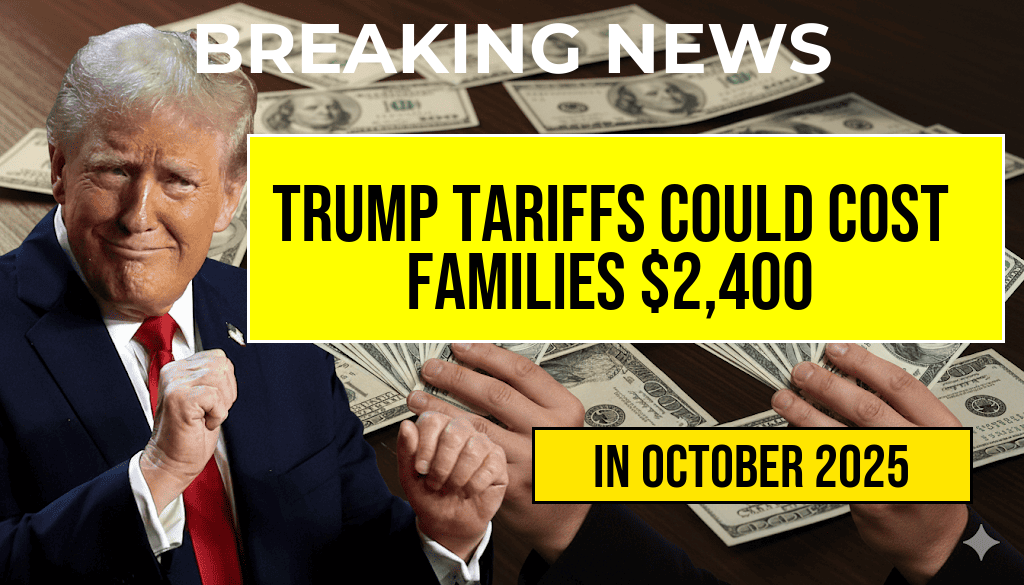Recent analyses suggest that the ongoing implementation of tariffs under the Trump administration could significantly impact American households, with some families facing an annual increase of up to $2,400 in costs. Dubbed the “Turbulence Tax” by economic analysts, these tariffs—initially aimed at reducing trade deficits and protecting domestic industries—are now causing ripple effects across consumer prices, particularly in sectors like manufacturing, agriculture, and retail. As trade tensions persist, understanding how these tariffs influence everyday expenses becomes increasingly vital for American families. This article examines the mechanics behind the “Turbulence Tax,” breaks down potential financial burdens, and explores the broader economic implications.
What Are Trump Tariffs and How Do They Affect Consumers?
Tariffs are taxes imposed on imported goods, intended to make foreign products more expensive and encourage domestic manufacturing. During the Trump administration, tariffs targeted several key sectors, including steel, aluminum, and Chinese-made electronics, among others. While these measures aimed to bolster American industry, they also resulted in increased costs for a wide array of consumer goods.
Economists warn that tariffs often lead to higher prices for everyday products, which are then passed onto consumers. According to data from the Office of the United States Trade Representative, tariffs can distort the supply chain, raising costs for manufacturers and retailers, ultimately trickling down to households.
Breaking Down the ‘Turbulence Tax’
The term “Turbulence Tax” refers to the hidden and often underestimated costs that American families bear as a consequence of trade tariffs. Recent estimates indicate that the cumulative effect of tariffs on imported goods—ranging from electronics to household appliances—could add up to $2,400 annually for a typical family of four. This figure encompasses increased prices across various sectors, including:
- Electronics and appliances
- Clothing and textiles
- Food and beverages
- Automotive parts
How the Cost Adds Up
To understand this estimate, consider that tariffs have increased the cost of imported goods by an average of 10–25%, depending on the product category. For instance, a family purchasing electronics, which often rely on imported components, could see a price increase of approximately $300–$400 annually. Similarly, tariffs on imported clothing and footwear may add around $200–$300 per year to household expenses.
| Product Category | Average Cost Increase | Estimated Annual Impact |
|---|---|---|
| Electronics & Appliances | 10–15% | $300–$400 |
| Clothing & Footwear | 10–20% | $200–$300 |
| Food & Beverages | 5–10% | $150–$250 |
| Automotive Parts | 15–25% | $500–$900 |
| Total | $1,350–$2,400 | |
Broader Economic Implications for American Families
Beyond direct product price increases, tariffs can influence broader economic factors that affect household finances. For example, higher manufacturing costs may lead to increased prices for goods, but can also impact employment levels and wage growth in affected sectors. Some businesses may reduce hiring or shift operations abroad to mitigate tariff-related costs, potentially influencing job stability and income prospects for American workers.
Moreover, tariffs can provoke retaliatory measures from trading partners, leading to trade disputes that further disrupt supply chains and market stability. This turbulence can translate into increased costs for businesses, which are often passed onto consumers in the form of higher prices or reduced product availability.
Policy Debates and Consumer Advocacy
Policy debates surrounding tariffs often center on balancing national security and economic growth with consumer affordability. Supporters argue that tariffs protect critical industries and promote fair trade practices, whereas opponents emphasize the risk of escalating costs for American families. Consumer advocacy groups warn that the “Turbulence Tax” disproportionately burdens lower- and middle-income households, exacerbating economic inequality.
According to economic analyses by organizations such as the Cato Institute, sustained tariffs can hinder economic growth, reduce consumer choice, and ultimately slow income growth for American families.
Potential Paths Forward
Experts suggest that reducing or eliminating tariffs could help mitigate the “Turbulence Tax” impact. Policymakers are encouraged to consider comprehensive trade strategies that promote fair competition while minimizing unintended costs for consumers. Additionally, increased investment in domestic manufacturing and supply chain resilience could offset some of the inflationary pressures caused by tariffs.
As the debate continues, families are advised to monitor their household budgets and explore ways to offset rising costs, such as seeking out alternative products or shopping during sales events. Staying informed about trade policy developments remains essential for understanding how these economic shifts might affect personal finances.
For more insights into U.S. trade policies and their economic impacts, resources such as Wikipedia’s page on International Trade and Forbes’ coverage on economic policy provide valuable context.
Frequently Asked Questions
What is the “Turbulence Tax” and how does it relate to tariffs?
The “Turbulence Tax” refers to the additional costs that American families may face due to tariffs imposed during the Trump administration. These tariffs can increase the prices of imported goods, leading to higher expenses for consumers.
How much could my family potentially pay annually because of these tariffs?
According to recent estimates, the “Turbulence Tax” could cost a typical American family up to $2,400 annually, depending on consumption patterns and the types of goods affected by tariffs.
Which types of products are most impacted by the tariffs and the resulting costs?
Products most affected by the tariffs include consumer electronics, clothing, household goods, and food items. These increased costs are passed down to consumers, contributing to the overall financial burden.
How do tariffs lead to higher costs for families?
Tariffs increase the cost of importing goods, which manufacturers and retailers often pass on to consumers. This results in higher prices for everyday items, effectively acting as a “tax” on families purchasing these products.
What can families do to mitigate the impact of the “Turbulence Tax”?
Families can consider buying domestic products, shopping for alternatives, or adjusting their consumption habits to reduce the financial impact. Staying informed about tariff changes can also help consumers make more cost-effective choices.






